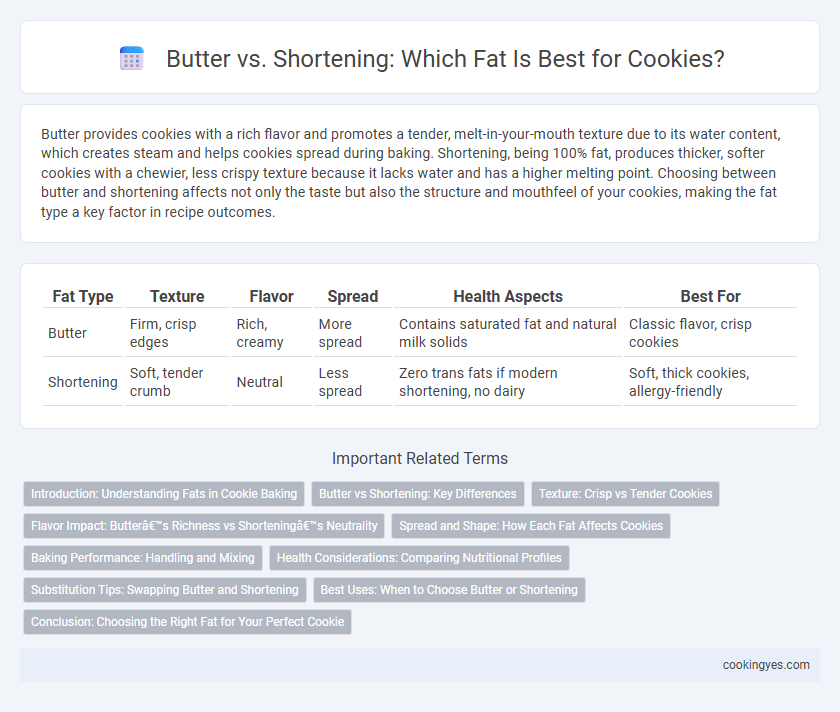Butter provides cookies with a rich flavor and promotes a tender, melt-in-your-mouth texture due to its water content, which creates steam and helps cookies spread during baking. Shortening, being 100% fat, produces thicker, softer cookies with a chewier, less crispy texture because it lacks water and has a higher melting point. Choosing between butter and shortening affects not only the taste but also the structure and mouthfeel of your cookies, making the fat type a key factor in recipe outcomes.
Table of Comparison
| Fat Type | Texture | Flavor | Spread | Health Aspects | Best For |
|---|---|---|---|---|---|
| Butter | Firm, crisp edges | Rich, creamy | More spread | Contains saturated fat and natural milk solids | Classic flavor, crisp cookies |
| Shortening | Soft, tender crumb | Neutral | Less spread | Zero trans fats if modern shortening, no dairy | Soft, thick cookies, allergy-friendly |
Introduction: Understanding Fats in Cookie Baking
Butter and shortening play crucial roles in cookie texture and flavor, with butter providing rich taste and slight crispness, while shortening ensures soft, tender results due to its higher melting point. Understanding the differences in fat composition and moisture content helps bakers choose the ideal fat source for desired cookie characteristics. The balance between butter's natural milk solids and shortening's pure fat content impacts spread, chewiness, and overall cookie quality.
Butter vs Shortening: Key Differences
Butter contains about 80% fat with natural milk solids and water, giving cookies a rich flavor and crisp edges, while shortening is 100% fat, providing a higher melting point that results in softer, fluffier cookies with less spread. The water content in butter aids Maillard browning, enhancing color and taste, whereas shortening's lack of water produces lighter textures but less flavor depth. Choosing butter yields flavorful, tender cookies with chewy or crispy textures, while shortening is ideal for achieving consistent, tender crumb without additional flavor complexity.
Texture: Crisp vs Tender Cookies
Butter creates cookies with a crisp texture due to its lower melting point and water content, which causes edges to spread and caramelize during baking. Shortening produces tender, softer cookies by preventing ingredients from binding tightly and maintaining structure with higher melting fat. Choosing butter enhances buttery flavor and crunch, while shortening favors moist, cake-like crumb and shelf stability.
Flavor Impact: Butter’s Richness vs Shortening’s Neutrality
Butter's rich, creamy flavor enhances cookies with a deep, buttery taste and aroma that is difficult to replicate, contributing to a more indulgent and satisfying cookie experience. Shortening offers a neutral flavor profile, allowing other cookie ingredients such as vanilla or chocolate to shine without interference. Choosing butter emphasizes flavor complexity, while shortening provides a blank canvas for other flavor elements in cookie recipes.
Spread and Shape: How Each Fat Affects Cookies
Butter, with its lower melting point and higher water content, causes cookies to spread more during baking, resulting in thinner, crisper edges. Shortening, which is 100% fat and melts at a higher temperature, helps cookies maintain a taller, softer shape by minimizing spread. Choosing butter enhances flavor and browning, while shortening offers greater control over cookie shape and thickness.
Baking Performance: Handling and Mixing
Butter offers superior baking performance with easy handling and smooth mixing due to its natural fat and moisture content, creating a tender cookie texture. Shortening provides more stability and higher melting points, resulting in consistently shaped cookies with minimal spreading during baking. Mixing with butter requires careful temperature control to prevent over-softening, while shortening allows for more forgiving dough consistency and easier incorporation.
Health Considerations: Comparing Nutritional Profiles
Butter contains saturated fats and cholesterol, which may raise LDL cholesterol levels, whereas shortening is typically trans fat-free but often made from hydrogenated oils that can include unhealthy trans fats. Butter provides natural vitamins A and E, while shortening lacks these nutrients and may contain artificial additives. Choosing between butter and shortening for cookies depends on balancing flavor preferences with health concerns, emphasizing the importance of checking ingredient labels for trans fat content and overall nutritional impact.
Substitution Tips: Swapping Butter and Shortening
Swapping butter for shortening in cookie recipes impacts texture; butter provides a rich flavor and crisp edges, while shortening yields softer, thicker cookies due to its higher melting point. When substituting, use a 1:1 ratio but reduce added salt if replacing salted butter with shortening. To maintain flavor while achieving a tender crumb, consider blending both fats or adding a touch of butter flavoring when using shortening alone.
Best Uses: When to Choose Butter or Shortening
Butter provides rich flavor and crisp edges, making it ideal for cookies that emphasize taste and browning, such as chocolate chip or sugar cookies. Shortening offers a higher melting point, resulting in softer, thicker cookies with a tender crumb, perfect for recipes like drop cookies and frosted sugar cookies. Choosing butter or shortening depends on desired texture and flavor intensity, balancing buttery richness against structural softness.
Conclusion: Choosing the Right Fat for Your Perfect Cookie
Butter imparts rich flavor and crisp edges to cookies, while shortening produces a softer, tender texture with more volume. For cookies where taste and browning are priorities, butter is ideal; for those needing height and chewiness, shortening works best. Selecting the right fat depends on your desired cookie outcome, balancing flavor, texture, and structure.
Butter vs Shortening for cookie fat Infographic

 cookingyes.com
cookingyes.com